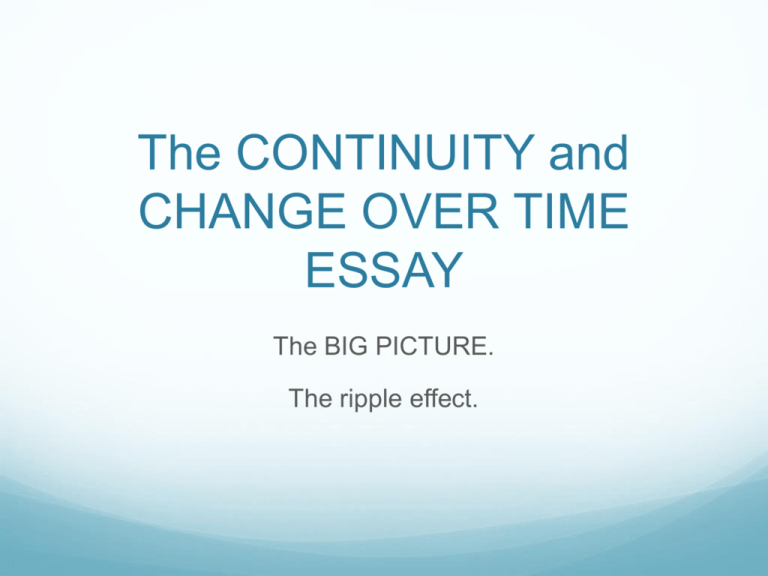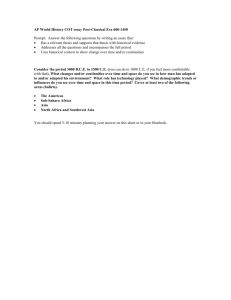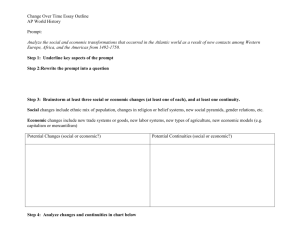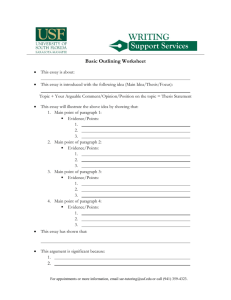CCoT Powerpoint - Jessamine County Schools
advertisement

The CONTINUITY and CHANGE OVER TIME ESSAY The BIG PICTURE. The ripple effect. The Change-Over-Time Essay One free response question deals with continuity AND change over time. In the essay you also give an analysis of the dynamics (causes and other factors) of change and continuity. Writing time: 40 minutes The Change-Over-Time Essay Underline, box, and/or note the key parts of the prompt. Write 2 examples or types of change & a piece of historical evidence for each change. For one of the changes, write a reason why the change took place or a possible result. Write 2 examples or types of continuity & a piece of historical evidence for each change. Write a thesis statement that contains the main elements of change and continuity from above. Define the topic at the starting point of the time period specified. (2 or 3 sentences) COT Essay Structure 1. Introduction with thesis – Prove something! 2. Be sure to answer all parts of the question (Change, continuities, political, economic, etc.) 3. Using a three stage frame work for your body paragraphs: Body paragraph #1: Set the stage. Discuss the characteristics of first “chunk” of time. Body paragraph #2: Describe a turning point in that society. It does not necessarily have to be in the middle of the period, but should be a source of change. Discuss the immediate impact of this turning point. Body paragraph #3: Discuss the characteristics of second “chunk” of time. Explain the impact of the turning point and analyze-why they occurred? (Both change and continuity) 4. Use a minimum of 5 or 6 pieces of evidence for each part of your essay. This evidence should include both changes and continuities. 5. In conclusion, the essay must connect to the big picture (the global context). The Change-Over-Time Essay Intro paragraph DEFINE the topic at the starting point: In the first few sentences, describe the beginning point of the topic under analysis. Include your thesis - Make sure that your thesis responds directly to the prompt and includes both CHANGE and CONTINUITY. - Make sure your thesis answers the question and attempts to prove something. Mention time periods. Example of an introduction and thesis The interaction between nomadic and settled peoples has affected world history for thousands of years. Between the years 600 and 1450, China was greatly influenced by nomadic peoples. The invasion of the Mongols led to the creation of the world’s largest empire and influenced China politically, economically and socially. Throughout the rule of the Mongols and the recovery after, however, China was able to maintain its unique identity and culture. Change Over Time Essay Question: Discuss the changes and continuities of the political and economic systems of ONE of the following areas from the years 500 BCE- 1450 CE. South Asia (India) West Africa East Asia (China, Japan) THESIS: The interaction with Muslim merchants starting in 700 CE transformed West Africa from decentralized tribes into powerful Kingdoms with extensive economic wealth that played a major role in the world. However, they maintained rule by native leaders and continued the slave trade. The Change-Over-Time Essay If the prompt is: Analyze the changes and continuities in world trade systems from 1450 to 1750. Your thesis might read: Around 1450 Asia and the Ottomans ruled the seas and land routes were still popular but by 1750 there were major changes in world trade as the Americas were connected to Eurasia and as Western Europeans began to dominate global sea trade. However, the overland trade routes of Asia continued to flourish. The Change-Over-Time Essay You could write: One major change in world trade was the opening of the Americas. World trade was altered not only in its patterns but its products. The precious metals and crops of the Americas and the Atlantic slave trade from West Africa to the Americas provided new wealth for Europeans. Another change was European dominance of the Indian Ocean trade. First the Portuguese, then the Spanish, Dutch, and English replaced Arab merchants as the carriers of goods in the Indian Ocean. The Change-Over-Time Essay You could write: A continuity in world trade includes the overland routes of Asia. Since the classical period, the products of Asia like silk and porcelain moved along the Silk Roads that connected East Asia to the Middle East. The Change-Over-Time Essay ANALYSIS of the Change or Continuity means that you give reasons for the change or continuity OR why the changes happened. Why did Europeans control the Americas? Why didn’t the Chinese stop European advancement? What made the Silk Roads last so long as a trade route? The Change-Over-Time Essay If one of your pieces of evidence was . . . First the Portuguese, then the Spanish, Dutch, and English replaced Arab merchants as the carriers of goods in the Indian Ocean. You could analyze this by writing. . . The innovations and advancements in ship building and firepower allowed the Europeans to overwhelm East African and Asian ships and trading ports. Or Though the Ming Chinese had the technology to control Asian sea trade, they chose instead to continue to make profits by allowing others to carry the goods to and from their ports. This gave the Europeans a chance to gain control over East African, Arab, and Indian merchants. Evidence and analysis Example of Environmental Change 1450-1750: There was a significant change to the global environment through the spread of plants and animals in this period. Evidence: For example, several food crops, like the potato and corn, became a staple in many regions (China) after its introduction from the Americas. Analysis: A population explosion resulted in China from these new food crops which created some of the social problems leading to the end of the Qing dynasty. More On Analysis Tell Why · Analyze the changes over time and the continuities · Analysis means asking and answering why the changes and continuities occurred. · Analysis works best when it is integrated into the body paragraphs. · Your essay should include the word because. “This is significant because…This changed over time because… Continuities and Conclusion • Continuities need to be relevant. If the essay prompt asked you to discuss economic aspects, the continuity should relate to economics. •Continuities need to be across time periods. •Include more than one continuity (in case one is incorrect) • The conclusion should NOT be the same as the introductory paragraph. Your conclusion is a summary of the main points that you made in your essay. Global Context In other words, what else is happening in the world? The global context point can be earned by effectively showing: · Comparisons to other regions · Connection to global processes · Interaction among regions A simple statement is all that is required to earn this point. · Ex: Mongol women, like European women, did not bind their feet as the Chinese women did. Words to express change/continuity: Change Modify Evolves Flux Adapt Turning point Varies Continuity After Emerged Differed Reform Transform Shifted Still Constant Remained Stable Secure Consistent Carried over Maintained Throughout Continued Status Quo Invariable The whole time Our Essay Topic In the time periods 600-1750 (Units II and III) the Western World went through a number of changes. These changes brought Western Europe from isolation to playing a major role in world affairs. For this essay you will: • Give a detailed analysis of Western Europe in the time period 600-1450 addressing the political, economic and social factors that guided Western development. • Discuss how Western Europe changed from 600-1450 to 1450-1750. Once again, you should address the major political, economic, and social themes. Idea for Structuring Your Essay • Introduction paragraph with a thesis Example of a thesis: From 600-1450 W. Europe was politically _______________, economically _______________, and socially ___________________ but as a result of _____________________ from 1450-1750 it became _______________, ________________, and ___________________.However, W. Europe remained _____________________. • Body Paragraph discussing W. Europe politically, socially, and economically in Unit 2 • Paragraph stating AND analyzing a causation of change • Body Paragraph discussing W. Europe politically, socially, and economically in Unit 3 • Paragraph discussing the continuities (what is still present in unit 3 that was there in unit 2) • Conclusion CHART: CHANGE OVER TIME 1ST CIVILIZATION & TIME PERIOD: Europe 600-1450 2ND CIVILIZATION & TIME PERIOD: Europe 1450-1750 Basic Features in 1st Time Period POLITICAL ECONOMIC Decentralized Feudalism Power of Catholic Church Absolutism Limited monarchies Parliament Rise of nations Manorialism Lack of trade *Crusades(cause of Exploration Columbian Exchange Mercantilism Coercive labor Commercial Rev. Inflation of silver change) RELIGIOUS Basic Features in 2nd Time Period Unity under Catholic Church Protestant Reformation Counter Catholic Reformation Key Changes Key Continuities - Centralization - Still fragmented - Decline of the power of the church - Not homogenous (like China) -Truly global - Drastic increase in trade - Importance of silver, sugar, and slaves - Sea-based empires -Power of the church declines - Power of monarchs increases - Need and want for eastern goods - Land routes continued - Religion still important to people Basic Features in 1st Time Period Basic Features in 2nd Time Period Key Key Continuities Changes SOCIAL Rigid structure (Nobles-KnightsMerchants/ArtisansSerfs) *Black Death (cause of change) INTELLECT OR ARTS Gothic architecture Painting about religion Eyeglasses, gunpowder, printing press Population Growth Urbanization Rise of merchant class Proletariat class Cultural Diffusion Renaissance Secularism Vernacular Enlightenment Scientific Revolution Sailing/navigational technology Women become merchants Education More social mobility Population increase cities - Humanism - Secularism - Questioning spirit Women still inferior Landed aristocracy Social structure - Modes of expression Change Over Time Essay Rubric BASIC CORE EXPANDED CORE Points 1) Has acceptable thesis. (Addresses the global issues and the time period specified.) 1 2) Addresses all parts of the question (though not necessarily evenly or thoroughly) 2 (1) · Addresses most parts of the question 2 3) Substantiates thesis with appropriate historical evidence · Partially substantiates thesis with appropriate historical evidence 4) Uses relevant world historical context effectively to explain change over time and/or continuity. 5) Analyzes the process of change over time and/or continuity. Subtotal Points Expands beyond basic core of 1 to 7 points. A student must earn 7 points in the basic core area before earning points in the expanded core area. Examples: Has a clear, analytical, and comprehensive thesis. Addresses all issues of the question (as relevant): global context, chronology, causation, change, continuity, effects, content. Addresses all parts of the question evenly. Provides ample historical evidence to substantiate the thesis. Provides links with relevant ideas, events, and trends in an innovative way. 0-2 (1) 1 1 7 Subtotal 2 TOTAL 9







